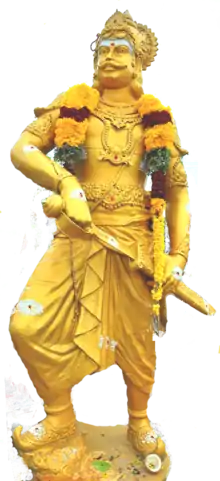Mutharaiyar dynasty
The Mutharaiyar dynasty was a royal family in what is now the Indian state of Tamil Nadu. They governed the Tanjore, Trichy and Pudukottai regions between 600-900 CE.

According to scholars, Earliest known line of Andhra Cholas Who were the descendants[1] of the great King Karikala were found in Renadu or Maharajapadi ( king's country ) from about the beginning of the sixth to the middle of the ninth century A.D. The family seems to have begun its rule at Erigal or Nidugal in the Tumkur district on the borderland between the Pallava and Kadamba dominions. The earliest king of whom we hear is Nandivarman, ( A.D. 500 ) whose name indicates a subordinate relation to the Pallavas of Kanchi. Of the three sons of Nandivarman, The Eldest - Simhavishnu ( another Pallava name ). The younger brothers of Simhavishnu were Sundarananda and Dhananjaya, the latter being described as Erigal Mutturaju Dhananjaya[2] ruling Renadu. All the brothers seems to have simultaneously ruled in different areas according to the Malepadu plates[3] of Punyakumara. A brief genealogy[4] of these clan was drawn by K. A. Nilakanta Sastri with the help of Melapadu plates
Dhananjaya was followed by his son Navarama or Mahendra vikrama I Chola Maharaja (AD.600) He holds the title Muditasilakshara, justified by his well - chiselled stone inscriptions.
Adhiraja Srikantha - A Pottapi Chola,[5] who is the king of Mylapore[5] - which is the south east part of Renadu. He is also called as Ottriyuran[6] as he is from Ottriyur region. ( Today's Tiruvottiyur ) We are able to trace Srikantha's ancestors[7][8][9] with the help of an Eastern Chalukyan king's Copper plate grants,[9] Anbil plates[8] of Parantaka Chola II and it's clear that he is from the lineage of Sundarananda, who is the 2nd son[4] of Nandivarma Chola. Also from Velanjeri plates of Parantaka I[6] & Anbil plates, its clear that Adhiraja Srikantha is the father of Vijayalaya Chola, who is founder of the Imperial Chola dynasty. Here we can see that Sundarananda was succeeded by the son (Navarama alias Mahendra vikrama I Chola Maharaja) of his younger brother Dhananjaya, its nothing wrong if we consider Sundarananda had Left no child. at first, Navarama was subordinate of Simhavishnu and Mahendra varman I of Kanchi, as evidenced by the resemblance of his titles with those of Mahendra - varman, he seems to have affirmed his independence later just like Simhavishnu Choda. He had a dugaraja ( Yuvaraja ) of Erigal under him, possibly his eldest son Gunamudita. The youngest son Punyakumara was Mutturaja of Erigal and over southern Renadu with Chippili as his capital. After Gunamudita's rule as king ( 620-25 ), he succeeded him in the rule of Renadu with Malepadu as capital.[10]
During the 7th to 8th centuries, the Mutharaiyar served as feudatories of the Pallava dynasty and controlled the fertile plains of the Kaveri region. An inscription in the Vaikuntha Perumal temple in Kanchipuram mentions a Mutharaiyar chief receiving Nandivarman II at the latter's coronation. According to historian T. A. Gopinatha Rao, this chief was Suvaran Maaran (also called Perumbidigu Muthurayar II).[11]
The Sendalai inscription of Suvaran Maran states that Tanjore and Vallam were under his control. When the Cholas came to power in 850, Vijayalaya Chola wrested control of Tanjore from the Mutharaiyar chieftains and turned them into vassals.[12]
References
- E.hultzsch (1911). Epigraphia Indica Vol.-11 p.339.
- Chhabra, B. ch (1947). Epigraphia Indica Vol.27 p.221.
- E.hultzsch (1911). Epigraphia Indica Vol.-11 p.337.
- "RBSI - Digital Rare Book: The Cholas By K.A. Nilakanta Sastri Published by The University of Madras - 1935 Read Book Online: http://bit.ly/2i2l8CX Download pdf Book: http://bit.ly/2iPIde5 Book Extract: p.103". www.rarebooksocietyofindia.org. Retrieved 1 June 2020. External link in
|title=(help) - "E-Publication | Department Of Archaeology, Kalvettu - Natana.Kasinathan & K.Dhamotharan p.19". tnarch.gov.in. Retrieved 5 June 2020.
- "Thiruttani and Velanjeri Copper Plates. See VELANCHERI PLATES OF PARANTAKA CHOLA I, Published by Dr.R.Nagaswamy". www.tamilartsacademy.com. Retrieved 5 June 2020.
- DASGUPTA, K. K. (1960). A COMPREHENSIVE HISTORY OF INDIA,VOL.3,PART1 p.384. PEOPLES OF PUBLISHING HOUSE.
- Thomas, F. w (1920). Epigraphia Indica Vol.15 p.46.
- DESAI, Z. A. (1898–99). EPIGRAPHIA INDICA VOL V p.123 (in Portuguese). SVCLRC, UDL TTD TIRUPATI. MANAGER OF PUBLICATIONS, DELHI.
- DASGUPTA, K. K. (1960). A COMPREHENSIVE HISTORY OF INDIA,VOL.3,PART1 p.381, 382. PEOPLES OF PUBLISHING HOUSE.
- H.S. Bhatia. Political, Legal And War Philosophy In Ancient India. Deep and Deep Publications, 2001 - India - 381 pages. p. 180.
- Indian History. Tata McGraw-Hill Education. p. B55.